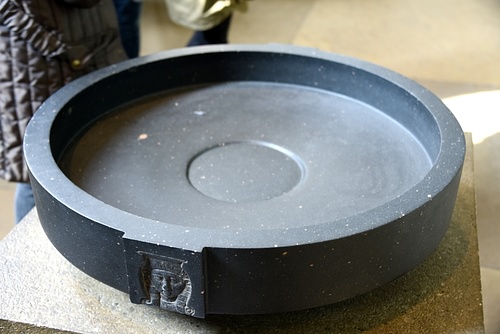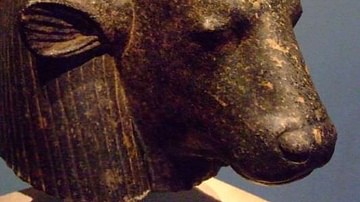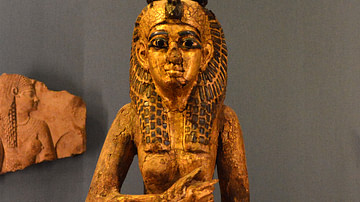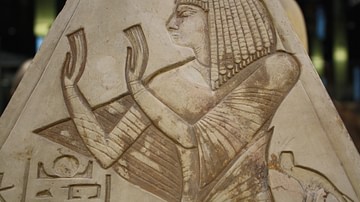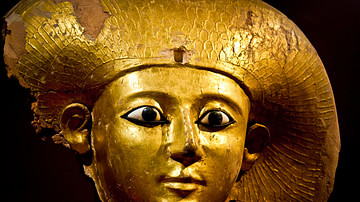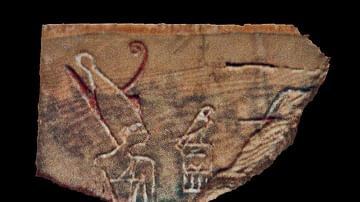The central cultural value of ancient Egypt was ma'at – harmony and balance – which maintained the order of the universe and the lives of the people. Keeping balance in one's life encouraged the same in one's family and, by extension outward, one's neighborhood, community, city, and the entire nation. A vital aspect of maintaining this balance was gratitude which would elevate a person's journey through life and, after death, allow one to offer one's heart – lighter than a feather – to the god Osiris in the Hall of Truth before passing on the paradise of the Field of Reeds.
Ingratitude was the “gateway sin” which opened the soul up to all the negative energies of doubt, distrust, envy, bitterness, and self-centered absorption. Through prayer, festivals, and personal religious observances, one could maintain a light heart, enjoy a full life and, after bodily death, be assured that one would not be judged harshly by Osiris and lose one's hope of paradise.
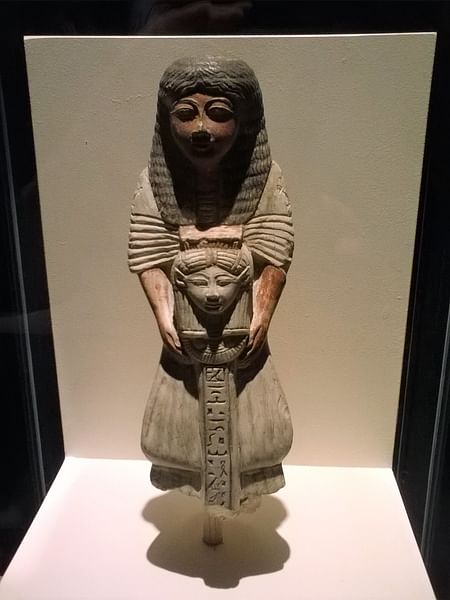
Hathor the Benevolent
Hathor was a multifaceted goddess, appealed to for a wide variety of needs, who provided many of the best aspects of life to humanity. Early depictions of the goddess show a queenly woman with the sun disk and horns on her head; later she came to be seen as a woman with the head of a cow or, simply, as a cow, symbolizing her life-giving energy and bounty toward humanity. She was a sky goddess, associated with Horus, an earth goddess – as attested by one of her epithets “Lady of the Sycamore” – a solar goddess (through her association with Ra), and also presided over affairs of the heart, sexuality, natural beauty, dance and music, diplomacy with foreign nations, fertility – of the land, people, and animals – and motherhood. She was also associated with the afterlife, consoling and guiding the souls of the dead, and was further linked with the Milky Way which was seen as a heavenly Nile River, sustainer of all life. She was so popular that, even in the period of the New Kingdom of Egypt (c. 1570 - c. 1069 BCE), when her attributes had been largely assumed by the goddess Isis, she was still venerated.
Central to all of Hathor's aspects was joy, which brightened the heart of the believer and enabled one to live a full and meaningful life. A prayer to Hathor, from the Stela of Ipui (18th Dynasty, c. 1500 BCE), emphasizes this aspect of the goddess. The prayer reads, in part:
Giving praise to Hathor, who lives in Thebes
Kiss the earth for reverence to her in all forms…
It was on the day that I saw her beauty
My mind was spending the day in celebration thereof –
That I beheld the Lady of the Two Lands in a dream and she placed joy in my heart.
Then I was revitalized with her food…
He who is wise
Will honor her at the seasonal festival
That which gives teaching to the people
Might be regarded to be pure food.
Near the servant in the Place of Truth, Ipui, the Justified, says:
In order to solve the problem of rivalry, jealousy, and coveting her,
The wonders of Hathor, which she did in ancient times,
Should be related to the ones who do not know and the ones who do know.
A generation should tell a next generation how beautiful she truly is. (Thompson, 4)

It was accepted that life was pursued within the context of a dangerous cosmos, and that this orderly pattern [established by the gods] was frequently disturbed by disasters which included illness, sudden or premature death, and natural dangers. Personal faith was needed to respond to life's tragedies, but affliction was not regarded as an overwhelmingly bad experience, because the sufferer could gain strength and spiritual sustenance from his loss. (271)
Hathor was the Egyptian deity most favorably disposed to help alleviate one's suffering, to provide comfort and restore balance, because she had once been the cause of human misery in her earlier incarnation as the vicious and blood-thirsty Sekhmet.
Hathor-Sekhmet & The Book of the Heavenly Cow
One of Hathor's many roles was as the figure known as the Distant Goddess; a female deity who leaves her celestial home, without leave from the great god Ra her father, and essentially runs away, forsaking her responsibilities. The Distant Goddess figure is associated with a number of female deities (Bastet, Mehit, Mut, and Sekhmet among them) but most famously with Hathor in The Book of the Heavenly Cow, composed during the First Intermediate Period (2181-2040 BCE) and the Middle Kingdom (2040-1782 BCE). In this work, however, the goddess does not run away of her own accord but is purposefully sent by Ra to destroy humanity.
As the story begins, humans are heard plotting to overthrow Ra because they feel he has become old and out of touch with their needs. They have forgotten all Ra has provided them and fallen into the sin of ingratitude. Ra hears of their plans and consults with the other gods on how to proceed. The primeval god Nun advises him to send his eye to teach humanity a lesson.
The Eye of Ra is usually depicted as a goddess who does Ra's bidding and is closely associated with the figure of the Distant Goddess because both, by their actions, bring about transformation. Ra chooses Hathor as his Eye, sending her to earth in the form of Hathor-Sekhmet to destroy humanity. Hathor-Sekhmet's fury is unleashed on the ungrateful humans and she kills thousands before Ra repents, recognizing there will soon be no one left, and tells her to stop. Hathor-Sekhmet has fallen into a crazed bloodlust, however, and cannot hear him.
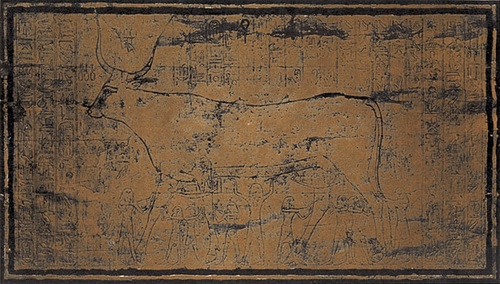
Ra orders 7,000 jars of beer mixed with red ochre, to resemble blood, and has the brew dropped at Dendera – Hathor's sacred site – where it pools across the plain. Hathor-Sekhmet arrives, seizes upon the 'blood' she finds, and drinks until she becomes so drunk she passes out. When she wakes up, she is the benevolent Hathor and, henceforth, the advocate and friend of humanity. This episode provides another of Hathor's epithets – “The Lady of Drunkenness” – which was especially invoked at festivals and gatherings where drinks were served in abundance.
Drinking, music, and dance were all a part of the worship of Hathor and, unlike other deities who had clergy of their same sex administering to them, the cult of Hathor included men and women as priests and priestesses. Another figure, however, who would have also been associated with Hathor (though certainly not exclusively) was the ta rekhet – the wise woman.
Wise Women
The ta rekhet (literally “the woman who knows”) is primarily attested in the New Kingdom through ostraca (inscribed ceramic shards) from the village of Deir el-Medina. According to scholar Carolyn Graves-Brown:
[The wise woman] seems to have been able to identify the gods which brought misfortune, look into the future, and diagnose illness. Such women were consulted by both men and women, with there being only one ta rekhet at any one time. Such women had a deep knowledge of the realms between the living, the gods, and the deceased. (80)
Graves-Brown goes on to note that these women may be attested to earlier in the Middle Kingdom, a possibility also suggested by Rosalie David who notes that these seers “may have been a regular aspect of practical religion” earlier than the period of the New Kingdom (281). This is likely when one considers the high status women of all social classes held throughout Egypt's history. These wise women of the New Kingdom may have been part of the ritual of the Five Gifts of Hathor, though this is by no means certain.

The Coffin Texts and the Book of the Dead have spells to help the deceased live forever as a follower of Hathor. In a Late Period story, Hathor rules the underworld, emerging to punish those who behave unjustly on earth. By the Greco-Roman period, dead women in the afterlife identified themselves with Hathor instead of Osiris. (139)
Wise women could – and probably did – invoke Hathor as afterlife goddess in addressing people's concerns. Graves-Brown notes an ostracon suggesting a wise woman was consulted on the reason for the death of a child and Hathor would have been the goddess to answer this since another of her responsibilities was to be present at a person's birth – in the form of the Seven Hathors – and decree the newborn's fate.
Hathor was worshipped by people of all social classes for the gifts she gave and, as scholar Alison Roberts notes, for her role as “the energizing agent of change, the vanquisher of inertia and other threats” (66). Though her cult center was at Dendera, and she was closely associated with Thebes, worship of the goddess was widespread throughout Egypt and was especially popular among the poor.
The Peasant Farmer's Lot
The farmers who worked the land almost never owned it. The king, as the living embodiment of the god Horus, was thought to own all the land and 'rented' it to nobles and priests. The produce from a plot was surrendered by the peasant farmer to the noble in charge, delivered to the storehouses of the Egyptian vizier, and then redistributed to the people so that no one should ever go hungry. Scholar Don Nardo comments:
Most arable land in ancient Egypt belonged to the pharaoh, his nobles, or the religious temples; they collected the bulk of the crops and the farmers kept a modest portion for themselves and their families. (12)
The crops included emmer wheat and barley, peas, lentils, and other vegetables and fruits. Every day during harvest time, the farmers would go to the fields, reach out with their left hand to grasp a stalk of wheat, cut it with a small scythe in their right hand, and leave it for the worker behind them to pick up in a basket. All day they farmed the land they did not own and had no hope of ever owning, their left hands always before their eyes reaching for the crops to harvest.
The Five Gifts of Hathor
When a poor farmer joined in the worship of Hathor, the priest or priestess would take hold of their left forearm and say, "Name the five things you would miss the most if you were to die right now." The person would have to name the first five things which came to mind without thinking too precisely on them - perhaps something like, "My wife, my children, beer, my dog, the river."
The priestess, priest, or – perhaps – wise woman, would then raise the person's left hand in front of the person's face and say, "These are the five gifts of Hathor", and the person would look at the five fingers of their left hand as the ritual would continue, "Every day you have at least these five things to be grateful for and, should you lose one, there will always come another." When that person went back out into the fields and reached out for the stalk of wheat to cut, under the hot sun, they would see their left hand always before them and be constantly reminded of the five gifts of Hathor.
As noted, the above ritual is poorly attested (this author has found no evidence for it outside of oral history in Egypt) and yet is in keeping with the spirit of the Cult of Hathor and the inherent nature of the goddess as bringer of joy, light, and gratitude. As soon as one stopped feeling grateful, one moved toward darkness and disbelief and bitterness in life. The Five Gifts of Hathor, which one could always remember by simply looking at the fingers of one's left hand, were constant reminders of all that was good and important and worth waking up for every morning - and giving thanks for every night.
Author's Note: Grateful acknowledgment to Ms. Amy Auset Rohn for inspiration and encouragement in preparing this article.
